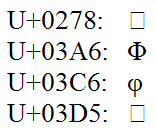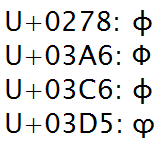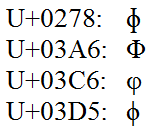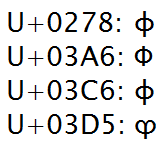Phi on You! Phi on You All!
December 27, 2007
Roscoe, N.Y.
The Vista machine I've been using in the guestroom of our little getaway house in the Catskills died last week of motherboard problems, and as a temporary solution I've switched to my tablet running XP SP2 so I can continue working on my book The Annotated Turing. I plugged my 20" monitor into the tablet's video output, and my beloved Microsoft Natural Ergonomic Keyboard 4000 v1.0 and my optical wheel mouse into the tablet's two USB ports, so it's almost like I'm using a real machine. Even the decrease in screen resolution from 1600×1200 to 1400×1050 is barely noticeable.
Today, however, I noticed a problem. Turing's paper — and mathematical papers in general — make liberal use of the lowercase Greek letter phi. My phi's had turned to boxes, and when I substituted Lucida Sans Unicode for the Times New Roman, I got my phi back but not the phi I wanted, and the one I thought I had.
Unicode defines four different codes for phi:
- Latin small letter phi as part of the International Phonetic Alphabet (IPA) extensions: U+0278 or ɸ
- Greek capital letter phi: U+03A6 or Φ
- Greek small letter phi: U+03C6 or φ
- Greek phi symbol: U+03D5 or ϕ
However, the actual glyphs you're seeing on the screen (if any) will depend on what font is being used to display this text on your system, and how old the font file is. The big confusion involves the 3rd and 4th codes. The Wikipedia article on phi directed me to this Unicode report that describes how the glyphs for U+03C6 and U+03D5 were actually swapped beginning with Unicode 3.0!
In most normal written Greek, the lowercase phi is a curly affair written with a single stroke. In mathematics, the phi is generally a circle with a vertical line through it. Beginning with Unicode 3.0, the U+03D5 glyph is the one to use in mathematics, and U+03C6 should be used for non-mathematical purposes, but there's no guarantee that these glyphs will be rendered consistently on older systems, or even newer systems with older font files.
Here's a tiny UTF-8 text file containing the four phi codes. Load it into Notepad and change the font. These screen shots show what I found:
In Windows XP SP2, the Times New Roman font supports only the capital and lowercase phi characters:

In Windows XP SP2, the Lucida Sans Unicode font supports all four phi characters, but the 3rd and 4th are based on the pre-Unicode 3.0 change:

In Windows Vista, the Times New Roman font adds the two other phi glyphs; the 4th is in accordance with the Unicode 3.0 glyph swap. This looks correct to me:

However, in Windows Vista, the Lucida Sans Unicode font has remained the same:

Now let's hope the correct phi gets onto the pages of my book!